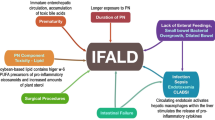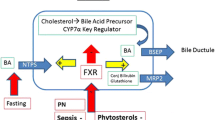Abstract
Parenteral nutrition associated liver disease (PNALD) is the major source of morbidity and mortality in children with short bowel syndrome (SBS). There is emerging evidence that omega-6 fatty acids (ω6FA) within the parenteral solution play a major role in PNALD and their effects may be reversed or ameliorated by substitution with omega-3 fatty acids (ω3FA). This paper reviews the mechanisms whereby ω3FAs may influence PNALD by improving bile flow, inhibiting steatosis, and having immunomodulatory effects. The early clinical experience with ω3FAs in SBS and PNALD is briefly reviewed and the implications of such, and future directions are considered.

Similar content being viewed by others
References
Andorsky DJ, Lund DP, Lillehei CW, Jaksic T, Dicanzio J, Richardson DS et al (2001) Nutritional and other postoperative management of neonates with short bowel syndrome correlates with clinical outcomes. J Pediatr 139:27–33
Warner BW, Ziegler MM (1993) Management of the short bowel syndrome in the pediatric population. Pediatr Clin N Am 40:1335–1350
Wales PW, de Silva N, Kim J, Lecce L, To T, Moore A (2004) Population-based estimates of incidence and mortality rates. J Pediatr Surg 39:690–695
Wales PW, de Silva N, Kim J, Lecce L, Sandhu A, Moore AM (2005) Neonatal short bowel syndrome: a cohort study. J Pediatr Surg 40:755–762
Sondheimer JM, Asturias E, Cadnapaphornchai M (1998) Infection and cholestasis in neonates with intestinal resection and long-term parenteral nutrition. J Pediatr Gastroenterol Nutr 27:131–137
Fecteau A, Atkinson P, Grant D (2001) Early referral is essential for successful pediatric small bowel transplantation: the Canadian experience. J Pediatr Surg 36:681–684
Teitelbaum DH, Tracy T (2001) Parenteral nutrition-associated cholestasis. Semin Pediatr Surg 10:72–80
Tulikoura I, Huikuri K (1982) Morphological fatty changes and function of the liver, serum free fatty acids, and triglycerides during parenteral nutrition. Scand J Gastroenterol 17:177–185
Zambrano E, El-Hennawy M, Ehrenkranz RA, Zelterman D, Reyes-Mugica M (2004) Total parenteral nutrition induced liver pathology: an autopsy series of 24 newborn cases. Pediatr Dev Pathol 7:425–432
Kelly DA (1998) Liver complications of pediatric parenteral nutrition—epidemiology. Nutrition 14:153–157
Javid PJ, Greene AK, Garza J, Gura K, Alwayn IP, Voss S et al (2005) The route of lipid administration affects parenteral nutrition-induced hepatic steatosis in a mouse model. J Pediatr Surg 40:1446–1453
Colomb V, Jobert-Giraud A, Lacaille F, Goulet O, Fournet JC, Ricour C (2000) Role of lipid emulsions in cholestasis associated with long-term parenteral nutrition in children. J Parenter Enteral Nutr 24:345–350
Iyer KR, Spitz L, Clayton P (1998) BAPS prize lecture: new insight into mechanisms of parenteral nutrition-associated cholestasis: role of plant sterols. British Association of Paediatric Surgeons. J Pediatr Surg 33:1–6
Van Aerde JE, Duerksen DR, Gramlich L, Meddings JB, Chan G, Thomson AB et al (1999) Intravenous fish oil emulsion attenuates total parenteral nutrition-induced cholestasis in newborn piglets. Pediatr Res 45:202–208
Calder PC (2006) n-3 polyunsaturated fatty acids, inflammation, and inflammatory diseases. Am J Clin Nutr 83:1505S–1519S
Deckelbaum RJ, Worgall TS, Seo T (2006) n-3 fatty acids and gene expression. Am J Clin Nutr 83:1520S–1525S
Arterburn LM, Hall EB, Oken H (2006) Distribution, interconversion, and dose response of n-3 fatty acids in humans. Am J Clin Nutr 83:1467S–1476S
Beckh K, Kneip S, Arnold R (1994) Direct regulation of bile secretion by prostaglandins in perfused rat liver. Hepatology 19:1208–1213
Zaman N, Tam YK, Jewell LD, Coutts RT (1997) Effects of intravenous lipid as a source of energy in parenteral nutrition associated hepatic dysfunction and lidocaine elimination: a study using isolated rat liver perfusion. Biopharm Drug Dispos 18:803–819
Alwayn IP, Andersson C, Zauscher B, Gura K, Nose V, Puder M (2005) Omega-3 fatty acids improve hepatic steatosis in a murine model: potential implications for the marginal steatotic liver donor. Transplantation 79:606–608
Alwayn IP, Gura K, Nose V, Zausche B, Javid P, Garza J et al (2005) Omega-3 fatty acid supplementation prevents hepatic steatosis in a murine model of nonalcoholic fatty liver disease. Pediatr Res 57:445–452
Neschen S, Moore I, Regittnig W, Yu CL, Wang Y, Pypaert M et al (2002) Contrasting effects of fish oil and safflower oil on hepatic peroxisomal and tissue lipid content. Am J Physiol Endocrinol Metab 282:E395–E401
Burdge GC, Wootton SA (2003) Conversion of alpha-linolenic acid to palmitic, palmitoleic, stearic and oleic acids in men and women. Prostaglandins Leukot Essent Fatty Acids 69:283–290
Willumsen N, Hexeberg S, Skorve J, Lundquist M, Berge RK (1993) Docosahexaenoic acid shows no triglyceride-lowering effects but increases the peroxisomal fatty acid oxidation in liver of rats. J Lipid Res 34:13–22
Halvorsen B, Rustan AC, Madsen L, Reseland J, Berge RK, Sletnes P et al (2001) Effects of long-chain monounsaturated and n-3 fatty acids on fatty acid oxidation and lipid composition in rats. Ann Nutr Metab 45:30–37
Nossen JO, Rustan AC, Gloppestad SH, Malbakken S, Drevon CA (1986) Eicosapentaenoic acid inhibits synthesis and secretion of triacylglycerols by cultured rat hepatocytes. Biochim Biophys Acta 879:56–65
Rustan AC, Nossen JO, Christiansen EN, Drevon CA (1988) Eicosapentaenoic acid reduces hepatic synthesis and secretion of triacylglycerol by decreasing the activity of acyl-coenzyme A:1, 2-diacylglycerol acyltransferase. J Lipid Res 29:1417–1426
Lochsen T, Ormstad H, Braud H, Brodal B, Christiansen EN, Osmundsen H (1999) Effects of fish oil and n-3 fatty acids on the regulation of delta9-fatty acid desaturase mRNA and -activity in rat liver. Lipids 34:S221–S222
Yeh SL, Chang KY, Huang PC, Chen WJ (1997) Effects of n-3 and n-6 fatty acids on plasma eicosanoids and liver antioxidant enzymes in rats receiving total parenteral nutrition. Nutrition 13:32–36
Calder PC (2006) Use of fish oil in parenteral nutrition: Rationale and reality. Proc Nutr Soc 65:264–277
Bellenger J, Bellenger S, Clement L, Mandard S, Diot C, Poisson JP et al (2004) A new hypotensive polyunsaturated fatty acid dietary combination regulates oleic acid accumulation by suppression of stearoyl CoA desaturase 1 gene expression in the SHR model of genetic hypertension. FASEB J 18:773–775
Clandinin MT, Van Aerde JE, Parrott A, Field CJ, Euler AR, Lien EL (1997) Assessment of the efficacious dose of arachidonic and docosahexaenoic acids in preterm infant formulas: fatty acid composition of erythrocyte membrane lipids. Pediatr Res 42:819–825
Senkal M, Geier B, Hannemann M, Deska T, Linseisen J, Wolfram G et al (2007) Supplementation of omega-3 fatty acids in parenteral nutrition beneficially alters phospholipid fatty acid pattern. JPEN 31:12–17
Heller A, Koch T, Schmeck J, van Ackern K (1998) Lipid mediators in inflammatory disorders. Drugs 55:487–496
Broughton KS, Wade JW (2002) Total fat and (n-3):(n-6) fat ratios influence eicosanoid production in mice. J Nutr 132:88–94
Grimm H, Tibell A, Norrlind B, Blecher C, Wilker S, Schwemmle K et al (1994) Immunoregulation by parenteral lipids: impact of the n-3 to n-6 fatty acid ratio. JPEN 18:417–421
Cooper AL, Gibbons L, Horan MA, Little RA, Rothwell NJ (1993) Effect of dietary fish oil supplementation on fever and cytokine production in human volunteers. Clin Nutr 12:321–328
Endres S, Ghorbani R, Kelley VE, Georgilis K, Lonnemann G, van der Meer JW et al (1989) The effect of dietary supplementation with n-3 polyunsaturated fatty acids on the synthesis of interleukin-1 and tumor necrosis factor by mononuclear cells. N Engl J Med 320:265–271
Weber C, Aepfelbacher M, Lux I, Zimmer B, Weber PC (1991) Docosahexaenoic acid inhibits PAF and LTD4 stimulated [Ca2+]i-increase in differentiated monocytic U937 cells. Biochim Biophys Acta 1133:38–45
Weber C, Erl W, Pietsch A, Danesch U, Weber PC (1995) Docosahexaenoic acid selectively attenuates induction of vascular cell adhesion molecule-1 and subsequent monocytic cell adhesion to human endothelial cells stimulated by tumor necrosis factor-alpha. Arterioscler Thromb Vasc Biol 15:622–628
Yagaloff KA, Franco L, Simko B, Burghardt B (1995) Essential fatty acids are antagonists of the leukotriene B4 receptor. Prostaglandins Leukot Essent Fatty Acids 52:293–297
Morlion BJ, Torwesten E, Lessire H, Sturm G, Peskar BM, Furst P et al (1996) The effect of parenteral fish oil on leukocyte membrane fatty acid composition and leukotriene-synthesizing capacity in patients with postoperative trauma. Metabolism 45:1208–1213
Furst P, Kuhn KS (2000) Fish oil emulsions: what benefits can they bring? Clin Nutr 19:7–14
Aprahamian CJ, Chen M, Yang Y, Lorenz RG, Harmon CM (2007) Two-hit rat model of short bowel syndrome and sepsis: independent of total parenteral nutrition, short bowel syndrome is proinflammatory and injurious to the liver. J Pediatr Surg 42:992–997
Perin N, Jarocka-Cyrta E, Keelan M, Clandinin T, Thomson A (1999) Dietary lipid composition modifies intestinal morphology and nutrient transport in young rats. J Pediatr Gastroenterol Nutr 28:46–53
Gura KM, Duggan CP, Collier SB, Jennings RW, Folkman J, Bistrian BR et al (2006) Reversal of parenteral nutrition-associated liver disease in two infants with short bowel syndrome using parenteral fish oil: implications for future management. Pediatrics 118:e197–e201
Lee S, Gura KM, Arsenault DA, Kim S, Strijbosch RAM, Modi BP et al. Parenteral nutrition-assoicated liver disease and omega-3 lipid emulsions: preliminary findings on safety and efficacy. 38th Annual meeting of the American Pediatric Surgical Association, Orlando 2007
Wales PW, Diamond IR, Sterescu A, Pencharz PB, Kim JH. Changing the paradigm: omegaven for the treatment of liver failure in pediatric short bowel syndrome. 39th Annual meeting of the Canadian Association of Pediatric Surgeons. St Johns, Newfoundland, 2007
Gura KM, Parsons SK, Bechard LJ, Henderson T, Dorsey M, Phipatanakul W et al (2005) Use of a fish oil-based lipid emulsion to treat essential fatty acid deficiency in a soy allergic patient receiving parenteral nutrition. Clin Nutr 24:839–847
Weber TR, Keller MS (2002) Adverse effects of liver dysfunction and portal hypertension on intestinal adaptation in short bowel syndrome in children. Am J Surg 184:582–586
Acknowledgments
Ivan Diamond was supported by a Fellowship award from the Canadian Institutes of Health Research with additional support from the Surgeon Scientist Training Program, Department of Surgery, University of Toronto.
The authors wish to acknowledge the following member of the GIFT team (our multidisciplinary intestinal rehabilitation team) for their contributions: A. Bossert, J. Bowers, J. Brennan, M. Carricato, G. Courtney-Martin, L. Coxson, E. Dales, N. de Silva, M. De Angelis, A. Fecteau, D. Fierheller, D. Grant, D. Harrison, J. Hawes, L. Ives-Baine, P. Kean, C. Koziolek, K. Lang, S. Ling, M. Mackenzie, J. Maxwell, A. Moore, K. Murch, C. Newman, V. Ng, E. Rosen, J. Tyrell, A. Wheat, and M. Zachos.
Disclosure
The authors have received preliminary approval of funding from Fresenius Kabi, the manufacturer of Omegaven®, for an investigator initiated randomized trial to examine a novel omega-3 containing parenteral emulsion for the prevention of parenteral nutrition associated liver disease in children with short bowel syndrome.
Author information
Authors and Affiliations
Corresponding author
Rights and permissions
About this article
Cite this article
Diamond, I.R., Sterescu, A., Pencharz, P.B. et al. The rationale for the use of parenteral omega-3 lipids in children with short bowel syndrome and liver disease. Pediatr Surg Int 24, 773–778 (2008). https://doi.org/10.1007/s00383-008-2174-0
Accepted:
Published:
Issue Date:
DOI: https://doi.org/10.1007/s00383-008-2174-0




